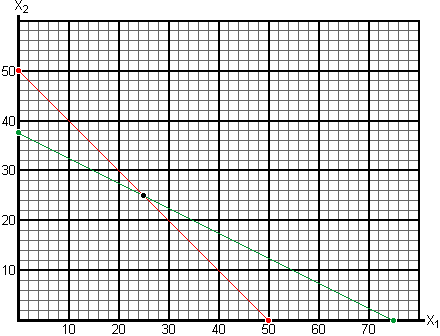

1. A woman wants to use milk and orange juice to increase the amount of calcium and vitamin A in her daily diet. An ounce of milk contains 37 mg (milligrams) of calcium and 57 mcg (micrograms) of vitamin A. An ounce of orange juice contains 5 mg of calcium and 65 mcg of vitamin A. How many ounces of milk and orange juice should the woman drink each day to provide exactly 500 mg of calcium and 1,200 mcg of vitamin A? Develop a mathematical model for this problem and use your model to answer the question. Illustrate the solution on a graph.
Answer: The woman should drink 12.5 ounces of milk and 7.5 ounces of orange juice each day.
The mathematical model is shown below:

x1, x2 >= 0
This problem can be solved using an augmented matrix, a matrix equation, or Excel's Solver tool.
Augmented Matrix Solution
The augmented matrix is
![]()
Using a TI-83 calculator, the reduced row echelon form is
![]()

Points on calcium constraint line (shown in red): (0, 100), (12.5, 7), (13.5, 0).
Points on vitamin A constraint line (shown in green): (0, 18.5), (12.5, 7), (21, 0).

2. Federated Shipping, a national delivery service, charges a base price for overnight delivery of packages weighing 2 pounds or less and a surcharge for each additional pound (or fraction thereof). A customer is billed $29.95 for shipping a 5-pound package and $59.20 for shipping a 20-pound package. What is the base price and the surcharge for each additional pound? Develop a mathematical model for this problem and use your model to answer the question. Illustrate the solution on a graph.
Answer: The base price is $24.10 for a package weighing up to 2 pounds and $1.95 for each additional pound or fraction thereof.
The mathematical model is shown below:

x1, x2 >= 0
This model can be solved using an augmented matrix, a matrix equation, or Excel's Solver tool.
The augmented matrix is
![]()
Using a TI-83 calculator, the reduced row echelon form is
![]()
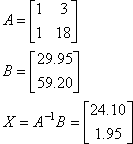
Points on 5-lb package constraint line (shown in red): (0, 9.98), (24.1, 1.95), (29.95, 0).
Points on 10-lb package constraint line (shown in green): (0, 3.29), (24.1, 1.95), (59.20, 0).

3. A company that rents small moving trucks wants to purchase 25 trucks with a combined capacity of 28,000 cubic feet. Three different types of trucks are available: a 10-foot truck with a capacity of 350 cubic feet, a 14-foot truck with a capacity of 700 cubic feet, and a 24-foot truck with a capacity of 1,400 cubic feet. How many of each truck should the company purchase? Develop a mathematical model for this problem and use your model to answer the question.
Answer: There are four solutions:
The mathematical model is shown below.

x1, x2, x3 >= 0
Because the number of equations is less than the number of variables, you can not use a matrix equation to solve this problem. You can't use Excel's Solver tool either. The solution is most easily found using an augmented matrix.
Here is the augmented matrix:
![]()
Using the TI-83, the reduced row echelon form is:
![]()
where
x1 - 2x3 = -30 means x1 = 2x3 - 30 x2 + 3x3 = 55 means x2 = 55 - 3x3
We are free to alter the value of x3 as long as neither x1 nor x2 becomes negative (since you can not have a negative number of trucks). Suitable values for x3 are 15, 16, 17, and 18:

You can easily verify that, for each solution, the number of trucks is 25 and the fleet capacity is 28,000 cubic feet.
Points on the count constraint plane (shown in red): (0, 0, 25), (0, 25, 0), (25, 0 0).
Points on the cubic feet constraint plane (shown in green): (0, 0,20), (0, 40,0), (0, 0, 80).
A linear equation in three variables represents a plane. The simultaneous solution is the line formed by the intersection of the two planes. this line is shown in black in the image below.
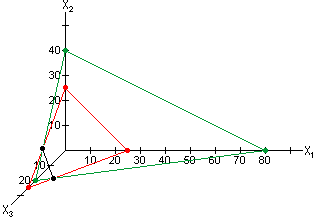
The four solutions listed above are points on this line as illustrated below. The top point is the solution (0, 10, 15), the next point is the solution (2, 7, 16), the next point is solution (4, 4, 17), and the bottom point is the solution (6, 1, 18).
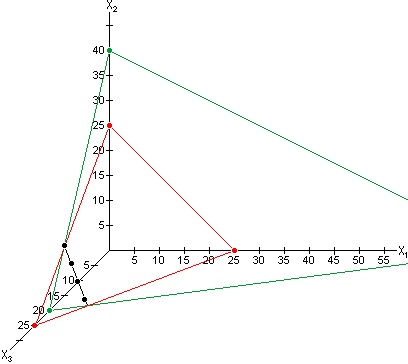
4. An investment advisor has two types of investments available for clients. A conservative type of investment currently pays a return of 10% per year. A riskier investment currently pays a return of 20% per year. An client has $50,000 to invest and wants a return of 15% per year. How much should the client invest in each type of investment? Develop a mathematical model for this problem and use your model to answer the question. Illustrate the solution on a graph.
Answer: The client should invest $25,000 in each type of investment.
The mathematical model is given below.

x1, x2 >= 0
You can use an augmented matrix, a matrix equation, or Excel's Solver tool to find the solution.
Here is the augmented matrix:
![]()
Using the TI-83, the reduced row echelon form is:
![]()
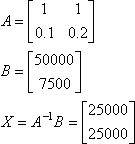
The scale on the coordinate axes is in thousands.
Points on amount invested constraint line (shown in red): (0, 50), (25, 25), (50, 0).
Points on return constraint line (shown in green): (0, 37.5), (25, 25), (75, 0).
